Teach your dog 15 tricks
By Michele Welton, Dog Trainer, Breed Selection Consultant, Author of 15 Dog Books
 Most dogs love learning tricks. When they discover that certain behaviors make you laugh and applaud and reward them, they will even offer those behaviors on their own, hoping for a positive reaction from you.
Most dogs love learning tricks. When they discover that certain behaviors make you laugh and applaud and reward them, they will even offer those behaviors on their own, hoping for a positive reaction from you.
Six Commandments For Teaching Tricks
- Offer treats.
- Practice for only two or three minutes at a time.
- Don't ask for the same trick more than three times in a row.
- Praise and encourage the very beginnings of a trick.
- Guide your dog gently with your hands.
- No corrections when teaching tricks.
No corrections? Then why do we use corrections for other words such as "Come" and "Stay"? Because the latter are essential commands, while tricks are optional bonus words.
If you can guide and encourage your dog to do a particular trick and he enjoys doing it – great! If he doesn't seem to understand a trick or struggles with it or doesn't like doing it, then don't ask him to do that trick.
So without further ado, here are some popular tricks!
"Shake hands"
 The classic dog trick. Even people who have never owned a dog will stretch their hand toward someone else's dog and say, "Hey fella, wanna shake hands? Gimme a paw!"
The classic dog trick. Even people who have never owned a dog will stretch their hand toward someone else's dog and say, "Hey fella, wanna shake hands? Gimme a paw!"
- Have your pup sit in front of you, facing you. With small dogs, kneel down to be closer to their eye-level.
- Extend your right hand, palm up, toward one of your dog's paws and in a cheerful voice, invite him to "Shake hands" or "Give a paw."
- With the fingers of your right hand, tap (or tickle) the back of your dog's front leg, down near his ankle. If he lifts his paw, say, "Good!" and give him a treat from your pocket. All he needs to do is lift the paw in response to your tap. Don't try to touch the paw at this point.
- After repeated successes, tap the leg and as his paw raises, slide your right palm under the paw so his foot is lightly resting on your palm. As soon as it touches your palm, say, "Good!" and provide the treat.
- Finally, hold out your hand, say the words, but don't tap his leg. If he doesn't respond, lower your hand closer to his ankle and make a tapping motion but without actually touching his leg. Hopefully this will remind him to lift his paw.
An occasional dog is reluctant to do this trick. When you touch his leg, he'll pull it back instead of raising his paw. Or he'll raise the paw, but not want to rest it on your hand. He may be afraid that you're going to grab or squeeze it. Be patient, but if he continues to resist this trick, don't push it on him.
"Play dead" (or "Naptime")
 This trick has practical uses. If your dog will lie on his side, it's easier to examine his stomach for fleas or burrs, or to cut out tangled hair.
This trick has practical uses. If your dog will lie on his side, it's easier to examine his stomach for fleas or burrs, or to cut out tangled hair.
There are two versions of this trick – the traditional one where you pretend to "shoot" your dog and he flops onto his side "dead" and a more peaceful version where the dog flops over to "sleep."
- Have him sit in front of you, facing you. With small dogs, kneel down to be closer to their eye-level.
- For the traditional version, form a "gun" with your right hand by pointing your right index finger at your dog, your other three fingers curled into your palm, your thumb sticking straight up. Say, "Bang!" or "Play dead!" as you jerk your hand slightly upward like a gun would recoil.
- For the "more peaceful" version, the hand signal is to extend your hand toward the dog, palm up, then flip that hand over so it's palm down. Say, "NAP time" or "Go to Sleep."
- Now show your dog what that word and hand signal means. Gently guide him into a down position and then flat on his side, repeating "Bang" or "Play dead" or "Nap time" a few times in a pleasant voice. Don't be fussy. The instant he reaches a semi-flat position, say, "Good!" and remove your hands as you reach for a treat.
- Gradually extend the time you hold him in the flattish position before you say "Good!" and release him. Then begin removing your hands so that he learns to stay flat even when you're not holding him. If he tries to get up, just replace him calmly without comment.
- Finally, you want him to lie down on his side without your needing to place him there. There's no special "trick" for accomplishing this: you just try to do it less and less with your hands, and more and more with suggestive motions and a strategic push here and there.
"Circle" (or "Spin")
 All your dog needs to do for this trick is to turn around in a tight little circle. But some dogs enjoy it so much that they start to spin multiple times. Some even chase their tail.
All your dog needs to do for this trick is to turn around in a tight little circle. But some dogs enjoy it so much that they start to spin multiple times. Some even chase their tail.
- With your dog standing in front of you, show him a treat. Say, "Circle" or "Spin" and lead his nose with the treat so he turns in a tight circle.
- When he has made one full revolution (so he's facing you again), praise him and give him the treat.
- When he will turn readily around being led by the treat, try motioning him in a circle with your treat hand, without actually putting it in front of his nose. "Circle!"
"Catch"
When giving a treat (or toy) to your dog, you don't always have to hand it to him. You can toss it to him and he can catch it.

Like this.
Well, okay, maybe not exactly like this!
- Position yourself so you're about a foot away from your dog. Once he notices that you have a treat, he will try to get closer, so you may need to dance around a bit to create some space between the two of you.
- Hold up the treat so he sees it. Say, "Catch!" and toss it gently toward his mouth.
- Be ready to move! Because if it bonks him on the head or falls to the ground, you want to grab it with your hand or cover it with your foot before he can snatch it up. He should only get the treat if he catches it. I know, sometimes it's easier said than done.
Some dogs have excellent eye-mouth coordination and learn this trick quickly. Other dogs take longer.
With a less coordinated or disinterested dog, try kneeling right in front of him. Hold the treat only a few inches from his mouth and toss it from there. Aim right for his mouth, which may encourage him to make a token grab for the oh-so-close treat.
Some dogs become uncomfortable when you toss anything toward them. If your dog is intimidated by a tossed treat, this is not the trick for him.
"Speak"
If your dog tends to be barky and you've spent time and effort teaching him to be quiet, you might think the last thing you'd want to do is reward him for barking.
And that might be true!
But by now you and your dog should have established a good leader-follower relationship. That means you should be able to teach him to do a particular something (bark on command) while still expecting him not to do other somethings (bark at things he has been told NOT to bark at).
In fact, ironically, many owners find it more difficult than they expected to get their dog to speak on command. It's as though the dog himself says, "You want me to bark for no reason? Are you crazy?"
- If you decide to give it a go, tie your dog to a post or doorknob while you stand just out of range with a tempting treat (or toy). Encourage him to "Speak" while waving the treat in a playful manner just a few inches from his nose.
- Hopefully this will elicit a bark or even a half-hearted rrr-rrr-rrr or token whine, whereupon you say, "Good!" and give him the treat. If he's reluctant, sometimes barking yourself ("Speak! Ruff! Ruff!") will motivate your dog to chime in.
- Once he gets the idea, add a hand signal by making a "talking mouth" with your hand, i.e. moving your fingers up and down so the four fingers close to touch the thumb, then open again, then close again, like a fast-talking mouth (gab-gab-gab).
As with all tricks, there are some dogs who just won't do this one. They stand there mutely, staring at you as you cavort around and cajole them to "Speak! Speak!". Hopefully your neighbors aren't peering in your windows.
Bonus word
 If your dog offers an especially unusual sound, such as a musical howl or a conversational grumble, give it a separate word, such as "Sing."
If your dog offers an especially unusual sound, such as a musical howl or a conversational grumble, give it a separate word, such as "Sing."
Encourage your pup (with praise and treats) to reproduce the sound and attach "Sing!" to it. Playing a musical instrument or certain recordings (usually high-pitched, such as opera) brings out the inner songster in some dogs!
"Beg"
 This is an old-fashioned trick where the dog lifts up both front feet, rocks back, and "sits up" on his hindquarters, like a squirrel or prairie dog.
This is an old-fashioned trick where the dog lifts up both front feet, rocks back, and "sits up" on his hindquarters, like a squirrel or prairie dog.
Some dogs, especially small dogs, can assume this position easily. Other dogs can't; perhaps the muscles around their backbone aren't strong enough or perhaps they don't have a good sense of balance.
I do NOT allow dogs with a long back (Dachshunds, Pekingese, Shih Tzus, Bassets, Bulldogs, etc.) to do this trick – it puts too much stress on the weak, deformed vertebrae in their long spine.
- Have your dog sit, facing you. Some owners find it helpful to put large dogs in a corner – facing OUT, of course, duh! The walls help provide support for balancing.
- Hold a treat just above your dog's head and say, "Beg" in a cheerful voice. If your dog tries to get the treat by rocking back on his hindquarters and lifting his front paws off the ground, even just a little bit, give him the treat and praise him.
 You need to hold the treat at just the right spot over his nose for him to sit firmly on his haunches and balance properly. You'll have to experiment to find the right spot for your dog. If you hold the treat too high, he'll stand up on his hind legs rather than rocking back onto his haunches.
You need to hold the treat at just the right spot over his nose for him to sit firmly on his haunches and balance properly. You'll have to experiment to find the right spot for your dog. If you hold the treat too high, he'll stand up on his hind legs rather than rocking back onto his haunches.- If you can't seem to lure your dog into lifting his front feet, you may need to lift his front legs yourself, rocking him slightly backward so that he settles onto his hindquarters. You can drape his feet lightly over your wrist or forearm to help him balance. Or try putting your hand under his chin to help him balance.
- This position can strain your dog's back muscles if done for too long. A few seconds is enough before giving him his well-earned treat.
"Dance"
 Dancing is different from begging. Begging asks your dog to sit up on his hindquarters and wait for you to give him the treat, while dancing asks your dog to stand up on his hind legs and waltz around, actively trying to solicit the treat.
Dancing is different from begging. Begging asks your dog to sit up on his hindquarters and wait for you to give him the treat, while dancing asks your dog to stand up on his hind legs and waltz around, actively trying to solicit the treat.
As with begging, I don't allow dogs with long backs to dance.
- Hold a treat just above your dog's head and say, "Dance! Dance!" When he reaches for it, raise it higher and wiggle it around to entice him to rise up on his toes and stretch for it.
- At first, the moment he stretches a little bit, give him the treat and praise him.
- Gradually coax him to stay up longer and dance around more. Repeat, "Dance! Good boy! Dance!" as he's sashaying around.
- You'll need to hold the treat higher than you do when he's begging, because you want him to stand up on his toes. But not TOO high, or he'll get frustrated and will simply bark or give up.
- As with begging, if the treat isn't enough to lure your dog into standing up on his toes, lift him up yourself. Once he's up on his toes, hold his paws very gently (don't squeeze!) or drape his front feet over your wrist and waltz around with him.
When I dance with my dog, I sing an old folk song, "Waltzing Matilda." No, I don't feel silly at all. Okay, maybe a little silly.
"Give a kiss"
Many dogs love this trick, while many others refuse to do it. Some dogs will kiss their family, but not a stranger.
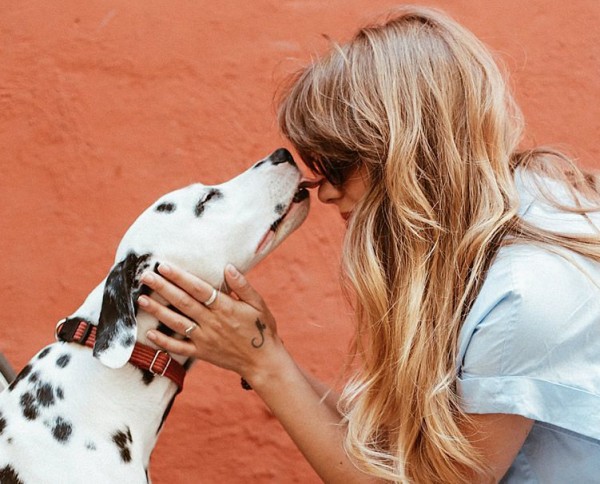
For those who like it, it's easy to teach. Whenever your dog licks your face on his own, say, "Give a kiss!" You can encourage him by dabbing a little peanut butter on your cheek.
Caution: YOU might think that being licked by a dog is wonderful, but many other people do NOT like to be licked. If you share your home with such people, you might not want to teach this trick, because it's hard for a dog to remember who he can kiss, and who he can't. Remember the value of consistent rules.
Also keep in mind that some people are allergic to canine saliva and can end up with a runny nose, runny eyes, or stuffed head from a simple kiss.
"Back up"
"Back up" is one of the most practical tricks if you need your dog to move backward a few steps.
- He may have followed you across your property line or through a gate.
- He may be too close to a delicate project you're working on, or to a potentially dangerous object.
- He may be too close to something he might frighten, such as your parakeet.
In all of these cases, moving backward a bit would put him in a better or safer position. Plus it's a fun trick as well as practical.
Here's how to teach "Back up":
- With your dog standing in front of you, show him this new hand signal: Hold your hand about a foot in front of your waist, palm facing you and fingers pointing toward the floor.
Now, keeping your wrist still, bend your hand and fingers away from you and then back toward you in a SLOWLY repeated flicking motion, as though shooing away a pesky critter.
Be sure to make this motion slowly. A more vigorous flicking motion belongs to the "Move" command.
- As you motion him backwards with your hand signal, say, "Back up. Back. Back." Take a few small steps toward him and repeat, "Back up. Back. Back." You're trying to crowd him so he'll step back.
- If he takes even one step backward, praise him and give him a treat.
If he knows how to "Catch", you can toss him the treat instead of handing it to him. Then you don't have to walk toward him, and he won't be tempted to run toward you. He can stay wherever he backed up to, and still receive his treat!
If instead of backing up in a straight line, he tries to sidestep you when you move toward him, practice in a hallway or other narrow passageway where he doesn't have much room to maneuver. If the only direction he CAN go is back, he'll learn it more quickly.
Over time, you'll want him to keep backing up as long as you keep flicking your wrist. And you'll want to cut down on stepping toward him and rely more on your hand motion and your voice to "back him up".
If time goes by, and he still won't respond without your stepping toward him, hold a lightweight stick or fly swatter vertically beside your leg. As you give him your hand signal and tell him to "Back up", raise the lower tip of the stick and tap him very gently on his foot or leg. That may do the trick (so to speak, haha).
"Say yes"
A simple trick of your dog nodding his head up and down can be made into a real performance if you play it up.
"Jake, I think it's cold today. Say YES if you agree!"
And your dog nods his head in agreement!
This is an easy trick to teach – but not necessarily an easy one for your dog to learn. I know that sounds cryptic, but I simply mean the teaching technique is obvious – you nod your own head as a signal while slowly moving a treat up and down so your dog's head does the same thing.
Many dogs will do it to follow the treat. And yet nodding isn't natural to dogs, so they might not progress to doing it without the treat. But it's such a great parlor trick that it's worth a try.
"Wave"
This is an extension of "Shake hands".
Once your dog will place his paw in your palm, you can progress to holding your palm outstretched and changing the command to "Wave". The familiar signal of your outstretched palm will probably be enough for him to lift his paw, and as soon as he does, praise him and give a treat.
Once he is reliably lifting his paw, change your hand signal from an outstretched palm (which belongs to Shake Hands) to a more wiggly motion like an actual wave.
He will understand this transition more quickly if you offer the new hand signal (the waving hand) right before the old hand signal (the outstretched hand). In other words, you "morph" the new signal into the old to give him confidence that he is doing the right thing and eventually you fade out the old signal entirely.
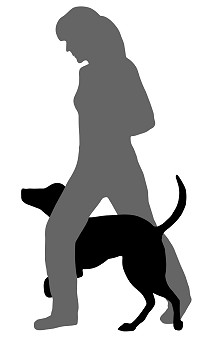
"Weave"
Wait, didn't we just do this one? Not exactly. That was WAVE This new trick is WEAVE.
In this trick, your dog does a Figure-8 pattern through and around your legs, like so...
From a starting position in front of you, he walks between your legs, veers to his left and comes around your right leg, then walks between your legs again and veers to his right to come around your left leg, ending up in front of you again. A figure-8 pattern.
How do you get him to do this? With treats, of course! You're going to coax him through the pattern with a treat held in front of his nose. "Weave. Good boy. Weave."
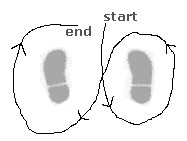
You'll actually want two treats, one in each hand.
- With the treat in your right hand, put that hand behind your right thigh and then move your arm over to your buttocks so the treat is visible to your dog between your legs. Use it to entice your dog through your legs and around your right leg. When he reaches his original position in front of you, give him the treat.
- Now use the treat in your left hand to do the same thing on the other side.
- Keep encouraging him to "Weave" as you coax him through the entire figure-8 pattern.
It's possible to do this trick as part of the heeling exercise. However, to combine the two, your dog must be able to heel off-leash because he needs to weave through your legs as you both walk. Very impressive!
"Front"
What does "Come" mean to your dog? Run toward you, right? Run all the way TO you, in fact.
But what happens once your dog reaches you? In general, we just want our dog to come close enough that we can easily take hold of his collar or snap on his leash.
But in obedience competition, when you call your dog, he must run to you and....
... sit in front of you, facing you.
Sitting in front of you, facing you, is a controlled position that can be very useful. When your dog is sitting facing you, he is focusing on YOU rather than whatever distraction you called him away from. Sometimes you need this kind of rapt attention!
So you want to teach your dog that "Front" means "Come sit in front of me, facing me."
You teach "Front" the same way you taught your dog his name and "Come".
- Stroll around the yard with your dog on-leash. When his attention is elsewhere, call, "Jake, front." Trot backwards, patting your hands in encouragement and repeating, "Front. Front."
- When he is just in front of you, STOP and use the leash and your hands to guide him into a Sit in front of you, facing you. Praise: "Good!" Then treat. Then release with "Okay!"
 As you practice this word, try to guide your dog into sitting close enough to you that when you extend your arm straight out, your palm is directly over his head. If he's even closer than that, fine, but you don't want him much further away than that.
As you practice this word, try to guide your dog into sitting close enough to you that when you extend your arm straight out, your palm is directly over his head. If he's even closer than that, fine, but you don't want him much further away than that.- If he is sitting too far away or really crooked (you're facing north or south, while he's facing east or west), take a few more steps backward as you repeat "Front" and try to get him sitting straighter, either using a treat to entice him into a better position, or the leash, or your hands. Gently, gently!
"Swing" and "Around"
These two practical tricks teach your dog to move from a position facing you (the FRONT position we just covered) to a position sitting on your left side and facing the same direction you are. This ending position is called heel position because it is the position from which you and your dog begin heeling.
Why TWO words: "Swing" and "Around"?
Because when your dog is sitting facing you, there are two directions he can go in, to get to your left side.
Direction #1: "Swing" to your left
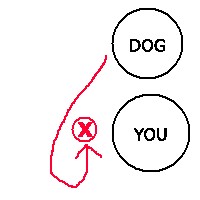 When your dog is front of you, facing you, he can move to your left in a curved arc to get into a sitting position beside you.
When your dog is front of you, facing you, he can move to your left in a curved arc to get into a sitting position beside you.
- With your dog sitting in front of you, facing you, hold a treat right in front of his nose.
- In a cheerful voice, say, "Swing." Take one large step backward with your left leg and sweep your left hand (holding the treat close to his nose) slowly in a large arc first outward to your left and then backward, then up beside your left leg.
The bigger your dog, the bigger your arc so that he has enough room to curve his body around the turn.
- As he makes that turn, step forward with your left leg so that he can follow your leg forward. Your leg should end up back where it started, and your dog should end up beside your leg and facing the same direction you are.
As soon as he gets there, say "Good!" and give him the treat. It's okay if he doesn't sit right now. You're just trying to teach him the Swing pattern.
- Over time, after many repetitions, you can stop luring with the treat and instead guide with the leash. With your left hand, grasp the leash fairly close to the clip. Do everything exactly the same, except that you're holding the leash instead of a treat. When he arrives in the right position, you can reach into your pocket for a treat.
- Next, you'll want to minimize guiding with the leash. Say, "Swing", step back with your left leg, and sweep your left hand in the familiar arc. If he doesn't start to move, put your hand on the leash and give it a gentle tug in the proper direction, just to get him up and moving. Repeat the hand signal if it helps remind him where to go.
- Finally, when he arrives in the proper position, ask him to Sit before giving him his treat. And of course you'll want to phase out the treats.
If you make this exercise a cheerful game, most dogs find it fun!
Direction #2: "Around" to your right
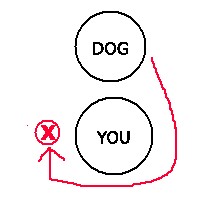 This word tells your dog to move to your right. He will go around behind you, and come up into a sitting position at your left side.
This word tells your dog to move to your right. He will go around behind you, and come up into a sitting position at your left side.
You'll follow nearly the same steps as for the previous word. But instead of moving your left leg and arm, you'll take the step back with your right leg and sweep your right arm to the right.
First, lure him with food. Then guide him with the leash. In both cases, the trickiest part comes when the dog passes behind your back, because you must transfer the food (or leash) from your right hand to your left hand.... when both hands are behind your back. Hopefully you have good coordination!
My best-selling books – now available FREE on my website
 Respect Training For Puppies: 30 seconds to a calm, polite, well-behaved puppy is for puppies 2 to 18 months old. Your puppy will learn the 21 skills that all family dogs need to know. Click here to read for free.
Respect Training For Puppies: 30 seconds to a calm, polite, well-behaved puppy is for puppies 2 to 18 months old. Your puppy will learn the 21 skills that all family dogs need to know. Click here to read for free. Teach Your Dog 100 English Words is a unique Vocabulary and Respect Training Program that will teach your adult dog to listen to you and do what you say. Click here to read for free.
Teach Your Dog 100 English Words is a unique Vocabulary and Respect Training Program that will teach your adult dog to listen to you and do what you say. Click here to read for free. 11 Things You Must Do Right To Keep Your Dog Healthy and Happy helps your dog live a longer, healthier life. Get my honest advice about all 11 Things before you bring home your new puppy, because some mistakes with early health care cannot be undone. Click here to read for free.
11 Things You Must Do Right To Keep Your Dog Healthy and Happy helps your dog live a longer, healthier life. Get my honest advice about all 11 Things before you bring home your new puppy, because some mistakes with early health care cannot be undone. Click here to read for free.
